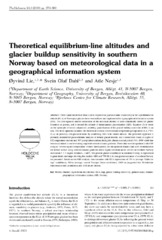| dc.description.abstract | Three equations derived from a close exponential glacier-climate relationship at the equilibrium-line altitude (ELA) of Norwegian glaciers have been utilized and implemented in a geographical information system (GIS). The first equation enables calculation of the minimum altitude of areas climatically suited for glacier formation at present, and is termed the altitude of instantaneous glacierization (AIG). Equation (2) is based on the ‘principle of terrain adaptation’, enabling quantification of the glacial buildup sensitivity (GBS) in an area. The third equation calculates the theoretical climatic (instrumental) temperature-precipitation ELA (CTPELA) in presently non-glaciated areas by combining GBS with terrain altitude. The presented approach is primarily intended for palaeoclimatic analyses of former glacial records, and is tested here based on a plot of 122 temperature stations and 197 precipitation stations during the climate normal period 1961–1990 which has been recalculated to sea level using empirical vertical climatic gradients. These data were interpolated in the GIS using an ‘inverse square interpolation’ routine. Subsequently, the interpolated climatic data were recalculated to the terrain surface using vertical climatic gradients and a digital elevation model (DEM) of southern Norway (resolution 5 3 5 degree minutes/c. 1 km2). The present glacier distribution in southern Norway is reproduced in great detail, and maps showing the modern GBS and CTP-ELA in non-glacierized areas of southern Norway are presented. Based on the GBS analysis, four scenarios with ELA depressions of 150 m (average ‘Little Ice Age’ conditions), 500 m (average coastal Younger Dryas conditions), 1000 m (suggested late Weichselian maximum coastal conditions) and 1500 m are shown. | en_US |
